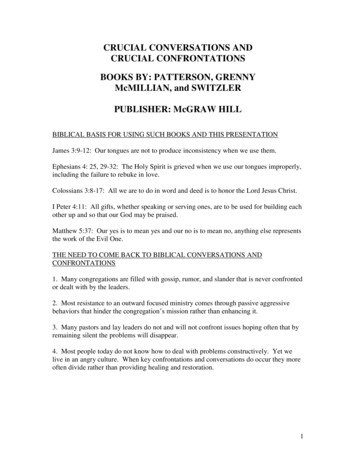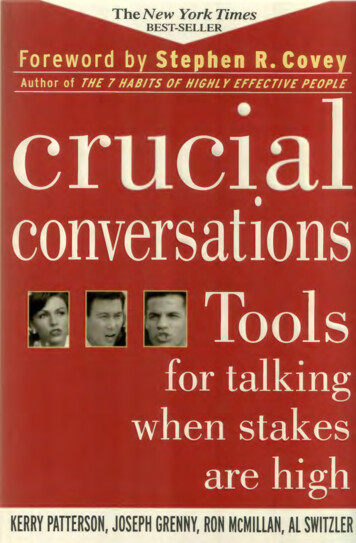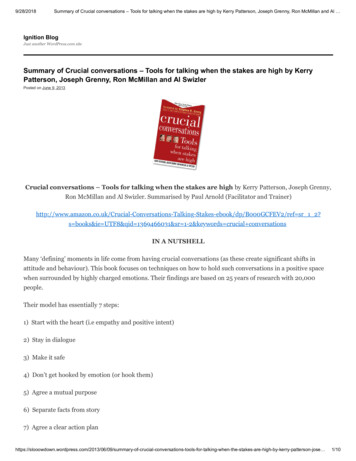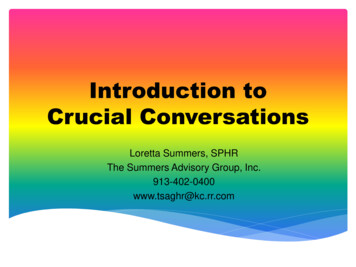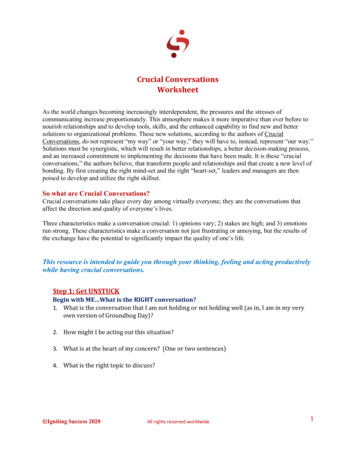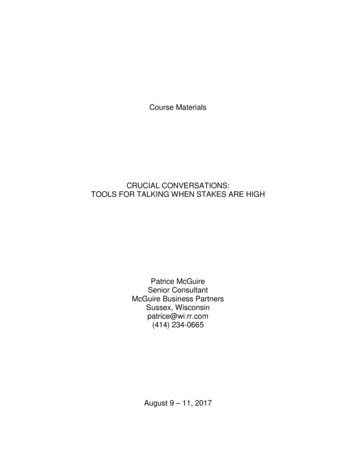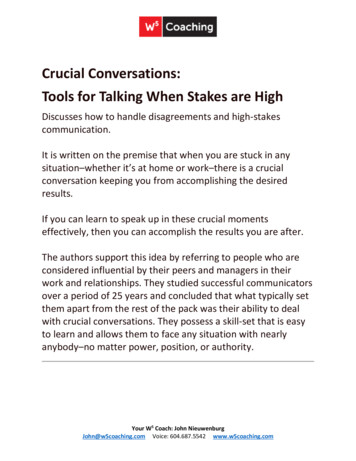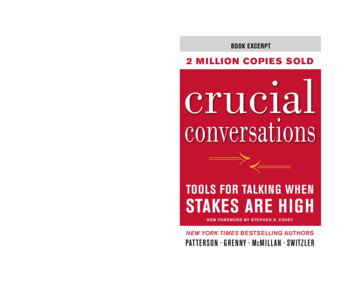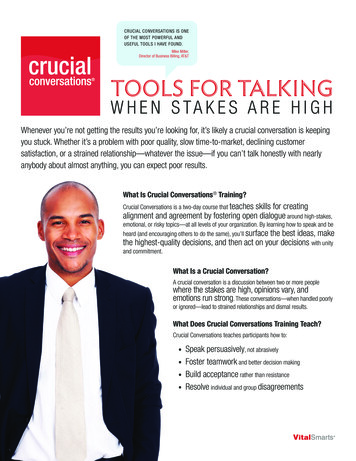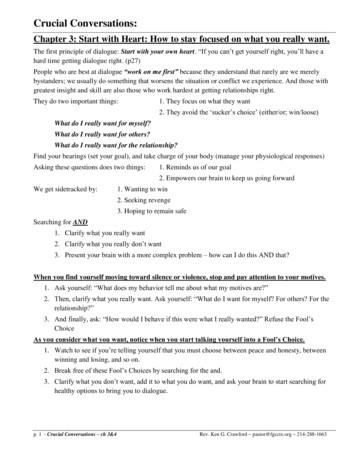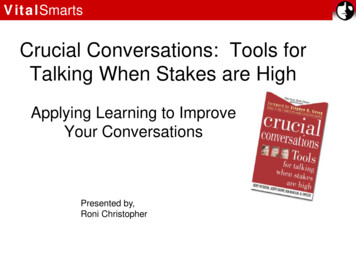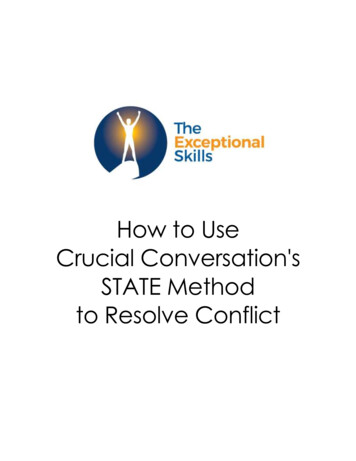
Transcription
How to UseCrucial Conversation'sSTATE Methodto Resolve Conflict
Dealing with conflict can be tough.Emotions are strong, words are said that should have been said, and ofteneveryone leaves feeling worse than when they started.It doesn’t have to be that way. You don’t have to resort to silence or violence.Kerry Patterson, Joseph Grenny, Ron McMillan, and Al Switzler in CrucialConversations give us a method to deal with conflict effectively. It’s called theSTATE method.STATE is an acronym and stands for:S – Share your factsT – Tell your storyA – Ask for the other’s pathsT – Talk TentativelyE – Encourage TestingHowever, before we get into each letter, we need to review a couple otherprinciples from the book first.Why’s that?Because the STATE method buildsoff these principles. Without them, you won’tbe able to use this method to its full potential.We’ll discuss the few principlesbriefly and then go into the STATE method.Let’s begin.(For more information about resolving conflict, visit our Ultimate Guide to ConflictResolution).2www.theexceptionalskills.com
The Pool of MeaningWhen disagreements happen, it often turns into a “who’s right” battle instead oflearning the other person’s perspective and resolving the issue.That not helpful. Instead, our goal should be to hear everyone’s perspective andlet them contribute to the “pool of meaning”.Why?Because each person has different feelings, opinions, viewpoints, andunderstanding of the situation. By combining it all together and getting all theinformation, we can make better decisions.And by understanding other people’s viewpoints better, we can better assess thesituation we are discussing to be able to better resolve the issue.The Path to ActionThe path to action goes like this:First, something happens. We see and/or hear it.Second, we tell a story about it.Third, we feel an emotion based off that story.3www.theexceptionalskills.com
Fourth, we act on that emotion.Let’s give an example:You are driving down the road and someone cuts in front of you. You get angryand yell at the person.What happened?Someone pulled in front of you. Those are the facts. That’s all you know.What happened next? You told a story about that person. You may have told thestory (assumed) that that person was selfish, rude, a jerk, etc.And you responded (with anger) based off that story.Tell a different storyWhat if you told a different story? What if your assumption about that personwas that the person was trying to get to the hospital because his or her child wasinjured in a wreck?Would you have had the same reaction then?You see, we tell a story when something happens, and our emotions are based onthat story, even if we don’t realize we told a story.By controlling your story, you can control your emotions. That’s one reason the“State Your Facts” part is first in the STATE method. You deal with the facts first.4www.theexceptionalskills.com
Start with youBefore you start a conversation with someone else, you need to deal withyourself first.The only person you can control is you. If you go into the conversation with thewrong motives, you are going to get a bad result.Before you go in, and if you catch yourself moving toward silence or violence(verbally attacking, demeaning, getting louder to control the conversation, etc.),ask:“What do I really want from this situation/conversation for myself/therelationship/the other person?”You may be ticked off, but if your motive is for a good relationship, go into theconversation with that motive and keep reminding yourself of your motive.And remember, in most situations, you have contributed to the problemsomehow, even if it's by you not standing up and saying something sooner.Look to see what contribution you had to the issue.Make it safePatterson and the others said that you can say anything to someone if the otherperson feels safe.Often conversations dealing with conflict go wrong because the other personfeels unsafe. They may feel the person is trying to control them, has ulteriormotives, and so on. So they get defensive.5www.theexceptionalskills.com
To help combat that, you can:Find a mutual purposeWhat is a mutual purpose that everyone can move toward? Do you both want abetter relationship? Do you want good working relationships? Do you want theproject to turn out well?Find a mutual purpose, some agreement, to build off.ApologizeIf you have done something wrong to the other person or have offended them,apologize, and be sincere.Apologizing can go a long way in making the other person feel safe.ContrastWhen you contrast, you say what you don’t mean then say what you do.This helps the other person know what your intentions are. For example, if youare discussing a report someone has spent time putting together, you might say:“I know you have put a lot of work into this report. I’m not saying that you’vedone a bad job or that you’ve been sloppy in it. What I’m saying is that I’mconcerned about how the stats ”Or in a relationship situation:“The last thing I want to do is give the impression that I am unhappy with the wayyou clean up after yourself. You do an amazing job. I just think that if we buysome new organizational bins, it might make it easier ”“Recognize the Purpose Behind the Strategy”Sometimes we will argue over strategies and not realize that we all have the samepurpose.6www.theexceptionalskills.com
You and your spouse or significant other may be arguing about where to go forthe evening. You both have the same purpose – you want to spend time witheach other. Your strategies are just different.If you take the time to find why each person wants that particular strategy – to goto that particular place or do that particular activity – then you can much easierwork out a solution that is agreeable to both.The STATE methodOkay, we’ve gotten those principles out of the way. Now let’s focus on how to dothe STATE method and how to incorporate these principles into it.The first three letters are the “what to do” and the last two are the “how to doit”.S - Share your factsWhen you start the conversation, state the facts first, not your story.Remember the path to action?First, something happens, and you see and/or hear it. Then you tell a story basedoff of those facts.The story isn’t facts. The story is an assumption. If you start off in yourconversation telling the person your story (your assumptions), there’s a goodchance you will never get to the facts.7www.theexceptionalskills.com
Facts are least controversial. They are the details that happened. It’s hard toargue facts (though there may be parts of the facts you are missing).If someone is constantly late, don't say or infer that they are lazy or unreliable.Just discuss the fact that they have been late this past week by 20 minutes everyday.T - Tell your storyThis is where you share the story, the assumptions, you made based off of thefacts.As we’ll discuss in the other “T”, when you share it, share the story as anassumption, not as a fact. You don’t know if that’s true – it just seems that way toyou.When they get defensiveThough the other person could possibly get defensive with the facts, the chancethat they will get defensive with your story is more likely. When/if that happens,remember the steps to make it safe: Find a mutual purpose – find what you both agree on.Example: You both want a better relationship and better communication.Contrast – say what you don’t mean, and what you do.Example: “I didn’t mean to diminish your contribution. You’ve put in a lot ofwork. What I’m trying to say .”"Recognize the purpose behind the strategy" – why do each of you wantwhat you want?Example: If everyone wants the car for the night, what they need is a wayto get from point A to point B. The argument isn’t about the car, it’s about away to get there.Also, when the other person gets defensive, your response might be to “fight”back. If you feel yourself going silent or violent, remember your reason and whatyou want out of this conversation and relationship.8www.theexceptionalskills.com
Back to telling the story itselfWith the person who is late, you might say:"When you are constantly late, it gives me the impression that you are unreliableand don’t care about how your lateness affects everyone else. Am I missingsomething about what’s going on?"With a boss who seems to check on you a lot:“Lately you’ve asked me to send every draft to you and check up with you everyday about the project. I get the impression that you may not trust me or my work.Is that the case or am I misunderstanding something?”A - Ask for the other’s pathsAfter you share the facts and tell your story, ask them to do the same.Remember the pool of meaning?The point of the conversation is not to prove that you are right, but to understandeach person’s perspective and resolve the situation (even if it means settingboundaries with the other person).If you go into the conversation telling the other person they are wrong and don’tlisten to their perspective, it’s not going to turn out well.Ask the other person their perspective and listen. Ask questions and dig deeper.Don’t interrupt or argue.You could say something like:“What are your thoughts?”“How do you see it?”“What’s your perspective?”“Do you see it differently?”9www.theexceptionalskills.com
“What’s going on?”“That’s how it appeared to me. Am I wrong somehow?”T - Talk TentativelyWhen you are sharing your story, remember that it’s an assumption, not a fact.Therefore, don’t share it as a fact. Share it tentatively, as a possibility, not as acertainty. You may find out that your assumptions are completely wrong.According to Merriam-Webster, tentative means:“Not fully worked out or developed” and “hesitant, uncertain”You may have noticed in the examples above that for each story, it was presentedas an opinion and how someone saw it, not as a fact.With the sample questions to get the other person to talk, each was giving thepossibility that you were wrong.Saying something like “it’s obvious to me” or “anyone would draw the conclusionthat.” “you did this because you meant to.” will only hurt you in resolving theissue.Instead, when you tell your story, say something like:“It seems to me that ”“In my opinion ”“it makes me wonder if ”“from my viewpoint.”“I get the impression that ”Also, tentative does not mean wimpy.Don’t say things like:“It’s probably not true, but ”“Call me crazy, but ”“This is probably stupid ”10www.theexceptionalskills.com
Your concern is important. Don’t treat it like it’s not.E - Encourage TestingWhen you ask the other person to speak, you want to encourage the other personto share their viewpoint, even if it is completely opposite.When you ask them to share, make sure they understand that you want to hearwhat they have to say no matter how controversial or opposing it is to what yousaid. And mean it.If someone is reluctant to speak up, you may have to try some other techniques(note: some may apply in some situations more than others).Play devil’s advocateYou may have to play devil’s advocate against yourself.“Let’s say I’m wrong. What if the opposite is true?”Continuous encouragementYou may have to keep asking them to test your statements. Keep encouragingthem to give you different viewpoints.AMPPPatterson and the others give another acronym to help get others to talk: AMPP.A- Ask to Get Things RollingM – Mirror to Confirm FeelingsP – Paraphrase to Acknowledge the StoryP – Prime When You’re Getting Nowhere11www.theexceptionalskills.com
A - Ask to get things rollingAsk the other person to speak up. You can use the questions we mentioned in theAsk section earlier.M – Mirror to confirm feelingsWhen you mirror, you reflect back to the person their feelings. Sometimes peoplewill say they are okay, but their tone and body language say otherwise.“You seem upset to me.”“You seem frustrated.”“You say you are fine, but by the tone of your voice, you seem frustrated.”P – Paraphrase to acknowledge the storyWhen you paraphrase, you take what the person said and put it in your ownwords. It acknowledges to the other person that you were listening and gives theother person a chance to correct you if you misunderstood.“So what you are saying is ”“Let me see if I got this right. You’re upset because ”P – Prime when you’re getting nowhereSometimes the other person will not open up. You may need to “prime” the otherperson to get them to talk.To prime, you guess what the other person might be saying. This is more of a lastresort.“Are you thinking that the reason I did this is to show off?”“Do you feel like I’m not considering your viewpoints when I make my decisions?”Remember the point is to encourage them to share their viewpoint so that youcan understand the situation better and resolve the issue.12www.theexceptionalskills.com
What happens if we disagree?Now, Patterson and the others gave this next tool for more of a context wheresomeone shares a concern (or you get them to share it using one the AMMP orprime method), but it can also be a good tool for our situation as well.This is the ABC method:A – AgreeB – BuildC – CompareA – AgreeFirst, when someone presents an issue or their viewpoint that you disagree with,find where you agree.“I agree, this whole process has been tough. You have put in a lot of hours”.B – BuildThen you build on it on something they may have missed or didn’t know.“I’ve also noticed that the whole department has been chaotic the past week ”C – CompareThen you compare the differences between your viewpoints. You don’t say thatone person is wrong and that you are right, you show the difference.“From my perspective, you feel that it’s been chaotic because of the changesin the structure. From my viewpoint, it’s because the department doesn’t want toreport to the new manager.”13www.theexceptionalskills.com
Coming to a solutionRemember, as you go through the process, focus on the reason you are havingthe conversation, your motive, and on the mutual purpose. Think about theconsequences of not having it or doing it poorly.Once each person has shared their viewpoints and discussed the issue, you thencan begin to discuss the next steps.Depending on the setting, you may work on it different ways.You may brainstorm and discuss possible solutions with the other person.Or, depending on the situation, you or someone else may make the decision. Or itmay be done be a vote.There may be situations where you must take a stand and set boundaries. Ifsomeone is clearly in the wrong (for example: constantly late or has othernegative behavior) and does not own to it, you may have to take other actions(such as firing them).If it's abusive or toxicIf someone is abusive or toxic or has some other negative behavior that isaffecting you and others, then you may need to completely get out of thosesituations and separate yourself from them or (depending what type of behavior)set a firm boundary that if that behavior continues, “X” will happen (such as, youwill not talk to them anymore until it changes).14www.theexceptionalskills.com
ConclusionDealing with conflict can be tough at times, but it is something you can do and dowell.The alternative of not dealing with it is worse: the behavior continues, therelationship is hurt, work productivity decreases, and so on.In this article we covered the importance of a shared pool of meaning, working onyourself first, the path to action, and the importance of making it safe.We then went through the STATE method – Share your facts, Tell your story, Askfor others’ path, Talk tentatively, and Encourage testing.We also covered how to deal with differing viewpoints and come to a solution.I hope this article helps you speak up and resolve the conflict in your life.Let me know your thoughts! What steps are you going to take next? Do you haveany related tips, suggestions, or examples?15www.theexceptionalskills.com
Kerry Patterson, Joseph Grenny, Ron McMillan, and Al Switzler in Crucial Conversations give us a method to deal with conflict effectively. It’s called the STATE method. STATE is an acronym and stands for: S – Share you
